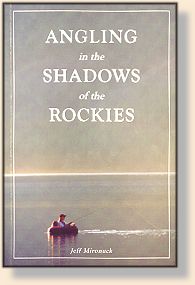Where To Start Fly Fishing
When Away From Home - Part 2
By Gerry Frederick
Getting Started
After you have arrived at the waters edge, be it lake or stream, slow down a little.
Now it's important to stop and observe everything you can. Make a mental
check list. My list is pretty simple; air temperature, clouds, sun, wind, water
level. But most important of all, what bugs do I see. On the water, in the
water or flying around. Look into the bushes and trees near the water edge.
Even give them a shake to see what fall or flies out. For example, if you shake
out a caddis from a nearby bush, take note of the size and color.
Sometimes we get lucky and it's clear from the start what is available to trout
at the spot we've picked. Most of the time it's not. That's O.K., now we have
to go with what we know. Keep with the K.I.S.S. method and don't over
think it. The more experienced fly fishers will have one or more "go to"
setups that work for them. Beginners need to fall back on the fundamentals.
My most common suggestion is stay below the surface as long as you can
hold out. Find a spot on the stream or lake that looks fishy. In rivers start
down stream, behind a rock that looks like it may hold fish. Close to a river
bank if it's deep enough is another spot to try. Tie on your favorite nymph
(I like a Beadhead Pheasant Tail) on a long leader, ten feet or so. Floating
line works best in water less than six feet deep.
Make sure you fish an area thoroughly. Cast several times in and around the
chosen spot. Adjust the speed of the retrieve every other cast. Watch the
line closely for any movement caused by a fish. Watch for fish following
the fly. Don't change the fly, move to a new spot and try it all again. Be sure
you have fished the first few spots thoroughly before changing flies.

I have often said that the presentation is more important than fly selection.
Be sure you have done all you can with the fly and location before changing.
Go with what you know or what you have learned. All too often anglers use
the fly as the excuse for no fish when actually it's presentation or location.
If you pick a productive fly and fish an area completely, then it could be
said the fish are not there or just not interested. Another reason the fish
won't take could be you stumbled up to the fishing hole and just spooked
them. If that's a possibility just move on and come back later. It has been
my experience that fish usually are not as picky as we have been lead to
believe. ~ Gerry Frederick
Next time the Flies!
Credits: From Angling in the Shadows of the Rockies
by Jeff Mironuck. We thank
Frank Amato Publications, Inc. for use permission!
Our Man In Canada Archives
|



